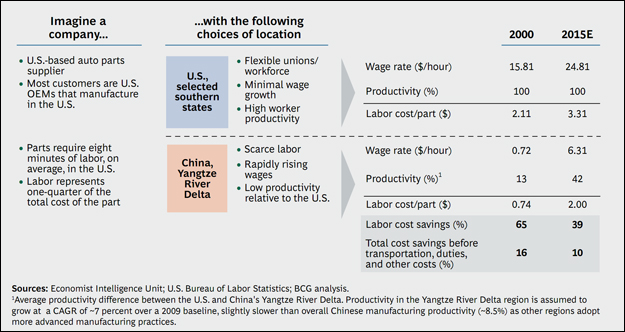Looking beneath a consulting firm's facade of objectivity
Different forecast, same premises
In “Made in America, Again,” BCG appears at first blush to have changed its tune, projecting that the United States is poised to enjoy a “manufacturing renaissance” and advising companies that producing in China should “no longer be the default option.”
Remapping Debate spoke with several manufacturing and corporate responsibility experts who had read the report. Without exception, they said that while the advice had changed, the underlying premise — that companies should move to wherever costs are lowest — had not.
“It’s essentially the same message,” said Scott Paul, executive director of the American Alliance for Manufacturing, a manufacturing policy think tank that receives funding from both the Steelworkers union and steel companies. “They’re saying, ‘Do what’s best for your bottom line.’”
“With its seemingly limitless supply of low-cost labor and an enormous, rapidly developing domestic market, an artificially low currency, and significant government incentives to attract foreign investment, China was the clear choice” for companies considering where to build manufacturing jobs, the report says.
“Now, however,” the report continues, “a combination of economic forces is fast eroding China’s cost advantage as an export platform for the North American market. Meanwhile, the U.S., with an increasingly flexible workforce and a resilient corporate sector, is becoming more attractive as a place to manufacturing many goods consumed on this continent.”
The report singles out the Southern states — where union membership and labor costs are low and where environmental and safety regulations are not as strict as in Northern and Midwestern states — as being the domestic destinations that firms should look to when considering re-shoring production.
Mark Price, a labor economist at the Keystone Research Center, a think tank in Harrisburg, Pa., that focuses on manufacturing policy, said that it was clear from that language that BCG was continuing to advocate that firms shift their resources based on a simple cost-benefit analysis concerning labor costs and regulations.
Indeed, the report does not predict that all companies that have moved production to China will re-shore, instead advising that some companies consider moving to even lower-cost countries — such as Indonesia, Thailand, or Mexico — that have a history of environmental and labor abuses.
“They’re not saying that companies should locate in the U.S., necessarily,” Price said. “They’re telling companies to go wherever labor costs are low.”
Selling the virtues of “labor market flexibility”
According to the report, among the primary advantages of producing in the Southern states — particularly Alabama, South Carolina, and Tennessee — are the high degree of “labor market flexibility” in those states and “minimal wage growth.” (See an exhibit to the report, “Economics will drive reinvestment in the U.S.,” below).
Price said that the phrase “labor market flexibility” is often understood to mean that workers have little power to control their wages and working conditions. “But it also means, ‘Don’t have a high minimum wage, have rules that restrict the choices workers have regarding unions, don’t have too many safety regulations, and limit the extent that workers have rights in regard to hiring and firing,” he said.
In an earlier version of the report, Mississippi was used as the comparison to China. When Harold Meyerson, a columnist at the Washington Post, pointed out to Harold Sirkin, one of the report’s three authors, that Mississippi ranks near the bottom of most measures of living standards, Sirkin said, “We made a mistake by picking Mississippi.”
In the updated version of the report, issued in August, South Carolina, Alabama, and Tennessee are the only states specifically mentioned (wages in these states are slightly higher and labor regulations marginally more extensive than in Mississippi). The report estimates that those states “will turn out to be among the least expensive production sites in the industrialized world” by 2015.
“You can’t help but come away from this report with the idea that the Southern states are the only states where we can compete in manufacturing, because those are states where we have cheap labor and fewer regulations,” said Kate Gordon, vice-president for energy policy at the Center for American Progress.
BCG: “Economics will drive reinvestment in the U.S.”
 |
Exhibit 3 of the report, reproduced with permission of BCG, presents limited choices for location in the U.S. and identifies “flexible unions/workforce” and “minimal wage growth” as among the desirable features of those locations.
